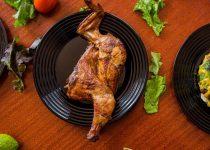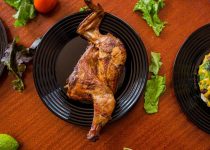How Long to Rotisserie an 8 Pound Chicken
You've got an 8-pound chicken to rotisserie, and you're wondering how long it'll take.
On average, an 8-pound chicken will take about 2 to 2.5 hours to rotisserie to juicy perfection.
Understanding the nuances of rotisserie cooking is crucial for achieving that succulent, evenly cooked bird.
From factors affecting cooking time to checking for doneness, this guide will equip you with the mastery you seek.
No need to fret about overcooking or undercooking – just a straightforward, expert approach to rotisserie cooking.
Let's dive in and get that bird spinning!
Key Takeaways
- The recommended cooking time for an 8-pound chicken on a rotisserie is approximately 2 to 2.5 hours.
- It is important to ensure the chicken reaches an internal temperature of 165°F for safe consumption.
- Factors like the temperature of the rotisserie and the size of the chicken can affect the cooking time.
- Checking for doneness can be done using a meat thermometer, visual cues, and checking multiple parts of the chicken.
Factors Affecting Cooking Time
To determine the factors affecting the cooking time of an 8-pound chicken on the rotisserie, you should consider the temperature and the size of the bird. Factors such as the initial temperature of the chicken, the consistency of heat in the rotisserie, and the size and weight of the bird play crucial roles.
The preparation techniques used before placing the chicken on the rotisserie can also influence the cooking time. For instance, a chicken that's trussed compactly will cook more evenly and, therefore, more quickly than one that isn't trussed.
Additionally, variations in the rotisserie equipment, such as the distance between the heat source and the chicken, can impact the cooking time.
Understanding these factors and the way they interact with each other will allow you to effectively manage the cooking time of an 8-pound chicken on the rotisserie. By mastering these factors and preparation techniques, you can consistently achieve a perfectly cooked rotisserie chicken, regardless of the specific equipment variations or cooking conditions.
Recommended Cooking Time
You should cook an 8-pound chicken on the rotisserie for approximately 2 to 2.5 hours, ensuring it reaches an internal temperature of 165°F for safe consumption. The cooking time can vary depending on factors such as the rotisserie temperature and the size of the chicken. Below is a table to guide you in understanding the recommended cooking time for an 8-pound chicken on the rotisserie.
| Rotisserie Temperature | Chicken Size | Recommended Cooking Time |
|---|---|---|
| 300°F | 8 lbs | 2 hours |
| 325°F | 8 lbs | 2 hours |
| 350°F | 8 lbs | 2 hours |
| 375°F | 8 lbs | 1.5 – 2 hours |
To ensure that the chicken is thoroughly cooked, it's essential to consider the rotisserie temperature and the size of the chicken. A higher rotisserie temperature may reduce the cooking time, but it's crucial to monitor the internal temperature of the chicken to guarantee that it reaches 165°F. Additionally, factors such as outdoor weather conditions and the specific rotisserie equipment being used can also influence the cooking time.
Checking for Doneness
After ensuring the recommended cooking time based on the rotisserie temperature and the size of the chicken, it's important to check for doneness by using a meat thermometer to confirm that the internal temperature has reached 165°F.
- Temperature Testing: Use a meat thermometer to check the thickest part of the chicken, ensuring it has reached 165°F. This is the safest way to confirm doneness.
- Uniform Doneness: Check multiple parts of the chicken, such as the thigh, breast, and wings, to ensure the entire chicken is uniformly cooked.
- Visual Cues: Look for visual cues of doneness, such as golden-brown skin and juices running clear. These are good indicators, but always confirm with a meat thermometer.
- Avoid Overcooking: Once the chicken reaches 165°F, remove it from the rotisserie to prevent overcooking, which can result in dry meat.
- Resting Period: Let the chicken rest for 10-15 minutes before carving to allow the juices to redistribute, ensuring a moist and flavorful result.
Resting the Chicken
Allow the 8-pound chicken to rest for 10-15 minutes before carving to ensure optimal juiciness and flavor. Resting the chicken after cooking is a crucial step that allows the juices to redistribute, resulting in a more succulent and tender meat. During this time, the residual heat will continue to gently cook the chicken while the juices, which have been forced towards the center during the cooking process, will have the opportunity to reabsorb into the meat, enhancing its overall flavor. There are several resting techniques that can further enhance the flavor and texture of the chicken:
| Resting Technique | Description | Benefits |
|---|---|---|
| Tenting with Foil | Cover the chicken loosely with foil to retain heat | Prevents the chicken from cooling too quickly |
| Resting on a Rack | Place the chicken on a raised rack for air circulation | Prevents sogginess on the bottom of the chicken |
| Patience | Allow the chicken to rest undisturbed | Allows for maximum redistribution of juices |
Carving and Serving
Now that the chicken has rested, it's time to carve and serve. Make sure to slice the chicken uniformly for a neat presentation. Consider efficient serving techniques to make the process smoother.
These points will help you serve up a delicious rotisserie chicken with ease.
Uniform Slices for Serving
When you're ready to carve and serve the 8 pound rotisserie chicken, ensure that the slices are uniform in thickness to provide an enjoyable dining experience for your guests. Uniform slices not only enhance the visual appeal of the dish but also ensure that each guest receives a consistent portion of tender, juicy meat.
To achieve uniform slices for serving, consider the following:
- Use a sharp carving knife to create even slices.
- Start by carving the breast meat, followed by the thighs and drumsticks.
- Maintain a steady hand and use smooth, deliberate motions.
- Consider presenting the slices on a platter or serving dish for an elegant touch.
- Arrange the slices neatly to showcase the succulent, golden-brown skin and juicy meat.
Ensuring uniform slices will elevate the overall presentation and dining experience for your guests.
Efficient Serving Techniques
Start by carefully cutting into the chicken, ensuring that each slice is uniform in thickness, to offer your guests an enjoyable dining experience.
When serving, presentation tips and carving techniques are crucial. Use a sharp knife to carve the chicken, slicing against the grain for tender pieces. Arrange the slices neatly on a serving platter to showcase your culinary skills.
Consider incorporating different seasoning options and flavor profiles to tantalize the taste buds of your guests. Experiment with aromatic herbs like thyme, rosemary, or sage for a fragrant and savory appeal. Additionally, you can infuse the chicken with citrus flavors or spicy rubs for a more adventurous palate.
Mastering efficient serving techniques will elevate the dining experience and leave a lasting impression on your guests.
Troubleshooting Overcooked Chicken
If your chicken turned out dry, don't worry—you can still salvage it. Adjust the cooking time for your next rotisserie chicken to ensure it stays juicy and flavorful.
Make sure to always check the internal temperature to prevent overcooking in the future.
Salvaging Dry Chicken
To salvage dry chicken, assess the level of dryness and consider incorporating moist ingredients like sauces or broths during reheating. When rehydrating dry chicken, it's important to take into account the seasoning options to enhance the flavor and moisture. Here are some tips for salvaging dry chicken:
- Check the level of dryness by cutting into the thickest part of the chicken.
- Use flavorful sauces or broths to add moisture during reheating.
- Consider shredding the chicken and incorporating it into dishes with sauces or gravies.
- Utilize acidic ingredients like citrus juices or vinegar to add moisture and flavor.
- Experiment with different seasoning blends and marinades to enhance the taste and texture.
Adjusting Cooking Time
Assess the internal temperature of the overcooked 8-pound chicken using a meat thermometer to determine the extent of the overcooking and the necessary adjustment in cooking time. If the chicken is overcooked, you can salvage it by adjusting the cooking temperature and employing basting techniques. Here's a helpful guide for adjusting the cooking time:
| Issue | Solution |
|---|---|
| Overcooked chicken with dry exterior | Lower the cooking temperature and increase basting frequency to keep the chicken moist. |
| Overcooked chicken with undercooked interior | Tent the chicken with aluminum foil to prevent further browning and continue cooking at a lower temperature until the internal temperature reaches 165°F. |
| Overcooked chicken with burnt skin | Carefully trim the burnt parts, baste the chicken, and continue cooking at a lower temperature until fully cooked. |
Checking Internal Temperature
Checking the internal temperature is crucial for troubleshooting overcooked chicken when using a rotisserie. To ensure the accuracy of the temperature, follow these steps:
- Use a reliable meat thermometer to check the internal temperature of the chicken.
- Insert the thermometer into the thickest part of the chicken, avoiding contact with bones.
- The chicken should reach an internal temperature of 165°F (74°C) for safe consumption.
- If the chicken is overcooked, consider adjusting the cooking time for future rotisserie sessions.
- To prevent overcooking, monitor the chicken closely towards the end of the estimated cooking time and make adjustments as needed.
Maintaining temperature accuracy and making cooking time adjustments based on the internal temperature will help you achieve perfectly cooked rotisserie chicken every time.
Rotisserie Chicken Leftovers
After enjoying your rotisserie chicken, you can easily store the leftovers in the refrigerator for future meals. Leftover chicken can be incredibly versatile and a great way to save time in the kitchen.
There are numerous creative recipes you can try with your leftover rotisserie chicken. From classic chicken salad and hearty soups to flavorful sandwiches and creamy pastas, the options are endless. You can also use the leftover chicken in casseroles, enchiladas, or as a topping for pizzas. The tender and juicy meat can elevate any dish, adding a rich flavor and protein boost.
When planning your meals, consider incorporating the leftover rotisserie chicken into your weekly menu. Whether it's a quick lunch or a satisfying dinner, having pre-cooked chicken on hand can make meal preparation a breeze.
Frequently Asked Questions
Can I Use the Rotisserie Function on a Grill Instead of a Dedicated Rotisserie Oven?
Yes, you can use the rotisserie function on a grill instead of a dedicated rotisserie oven. The benefits include smoky flavor and even cooking, but drawbacks may include uneven heat distribution and limited space. Other alternative cooking methods for chicken include roasting, grilling, and slow cooking.
How Can I Ensure That the Chicken Cooks Evenly on the Rotisserie?
To ensure even cooking on the rotisserie, monitor and adjust the temperature as needed. Keep the heat consistent and position the chicken properly to avoid hot spots. Rotate the chicken regularly for thorough and uniform cooking.
What Type of Seasoning or Marinade Works Best for Rotisserie Chicken?
For the best seasoning and ideal marinade for rotisserie chicken, consider options like garlic herb, lemon pepper, or BBQ rubs. Apply the seasoning generously and let the chicken marinate for a few hours before cooking for optimal flavor.
Can I Use an 8 Pound Chicken for Other Cooking Methods if I Don't Have a Rotisserie?
If you don't have a rotisserie, an 8-pound chicken can be cooked using alternative methods like roasting or grilling. Ensure the chicken reaches a safe internal temperature and follow proper food safety guidelines for handling poultry.
Are There Any Safety Precautions I Should Take When Using a Rotisserie to Cook a Chicken?
When using a rotisserie to cook a chicken, safety precautions are essential. Ensure rotisserie maintenance, proper chicken preparation, and cooking temperature are all in check. Always follow safety guidelines and handle raw chicken with care.



